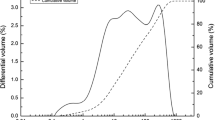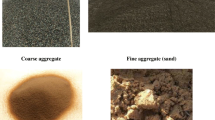Abstract
Construction industries have started to utilize manufactured sand (MS) as an effective alternative for river sand in concrete. High-grade parent rocks are crushed to obtain MS, which also produces a considerable amount of microfine aggregate (MFA). The higher percentage of MFA could lead to both positive and negative effects on the performance of cement-based mixes. This research was done to examine the influence of varying MFA levels, specifically 0%, 3%, 6%, 9%, and 12% (by weight) as the partial replacements of MS on bleeding and plastic shrinkage cracking of concrete. In addition to the varying MFA levels, some concrete mixes also included fly ash (FA) and superplasticizer to investigate the effect of free-water content in the mixes. The bleeding test data were taken as on-site measurements, while the cracks from the plastic shrinkage cracking test were evaluated using an image processing technique. The results concluded that the MFA replacements and the effective water-to-cement ratio have a significant effect on the selected concrete properties. With the increasing replacement levels, cumulative bleeding and crack initiation life gradually decreased, while a progressive increase was observed for crack width, crack length, and crack area.
Similar content being viewed by others
References
He H, Wang Y, Wang J. Effects of Aggregate micro fines (AMF), aluminium sulfate and polypropylene fiber (PPF) on properties of machine-made sand concrete. Applied Sciences (Basel, Switzerland), 2019, 9(11): 2250
Branavan A, Konthesingha K M C. Fine aggregate usage in concrete and masonry mortar by local construction industries. In: Proceedings of 10th International Conference on Structural Engineering and Construction Management (ICSECM). Kandy: Nethwin printers, 2019, 106–113
Gavriletea M D. Environmental impacts of sand exploitation. Analysis of sand market. Sustainability (Basel), 2017, 9(7): 1118
Cortes D D, Kim H K, Palomino A M, Santamarina J C. Rheological and mechanical properties of mortars prepared with natural and manufactured sands. Cement and Concrete Research, 2008, 38(10): 1142–1147
Ding X, Li C, Xu Y, Li F, Zhao S. Experimental study on long-term compressive strength of concrete with manufactured sand. Construction & Building Materials, 2016, 108: 67–73
Arulmoly B, Konthesingha C, Nanayakkara A. Performance evaluation of cement mortar produced with manufactured sand and offshore sand as alternatives for river sand. Construction & Building Materials, 2021, 297(7): 123784
Arulmoly B, Konthesingha C, Nanayakkara A. Effects of blending manufactured sand and offshore sand on rheological, mechanical, and durability characterization of lime-cement masonry mortar. European Journal of Environmental and Civil Engineering, 2021, 1–27
Li L, Wang B, Hubler M H. Carbon nanofibers (CNFs) dispersed in ultra-high performance concrete (UHPC): Mechanical property, workability and permeability investigation. Cement and Concrete Composites, 2022, 131: 104592
Abbas S, Nehdi M L, Saleem M A. Ultra-high performance concrete: Mechanical performance, durability, sustainability and implementation challenges. International Journal of Concrete Structures and Materials, 2016, 10(3): 271–295
Meng W, Khayat K G. Mechanical properties of ultra-high performance concrete enhanced with granite nanoplatelets and carbon nanofibers. Composites. Part B, Engineering, 2016, 107: 113–122
Arulmoly B, Konthesingha C, Nanayakkara A. Influence of mortars comprised of manufactured sand with offshore sand on the performance of masonry and brick-mortar joint. Innovative Infrastructure Solutions, 2022, 7(2): 160
Arulmoly B, Konthesingha C, Nanayakkara A. Influence of blended fine aggregates on the performance of lime-cement mortar—A statistical approach. In: Proceedings of 7th International Multidisciplinary Engineering Research Conference (MERCon 2021). Colombo: IEEE Xplore, 2021
Li B, Wang J, Zhou M. Effect of limestone fines content in manufactured sand on durability of low- and high-strength concretes. Construction & Building Materials, 2009, 23(8): 2846–2850
Wang J, Niu K, Tian B, Sun L. Effect of methylene blue (MB)-value of manufactured sand on the durability of concretes. Journal of Wuhan University of Technology—Material Science Edition, 2012, 27(6): 1160–1164
Li C. Effects of micro fines content on workability and mechanical properties of manufactured sand concrete. In: 2016 International Conference on Material Science and Civil Engineering (MSCE 2016). Guangzhou: MSCE, 2017
Stewart J, Novell J, Juenger M, Fowler D W. Characterizing minus No. 200 Fine Aggregate for Performance in Concrete. ICAR Technical Reports ICAR-107-1. 2006
Gotmare P G, Sheth A J. Influence of fines and microfines on properties of concrete. International Journal of Engineering Research in Mechanical and Civil Engineering, 2017, 2(4): 38–41
Hashemi M, Shafigh P, Abbasi M, Asadi I. The effect of using low fines content sand on the fresh and hardened properties of roller-compacted concrete pavement. Case Studies in Construction Materials, 2019, 11: 1–11
Boshoff W P, Combrinck R. Modelling the severity of plastic shrinkage cracking in concrete. Cement and Concrete Research, 2013, 48: 34–39
Sayahi F, Emborg M, Hedlund H, Cwirzen A, Stelmarczyk M. The severity of plastic shrinkage cracking in concrete: a new model. Magazine of Concrete Research, 2021, 73(6): 315–324
Radocea A. A model of plastic shrinkage. Magazine of Concrete Research, 1994, 46(167): 125–132
Uno P J. Plastic shrinkage cracking and evaporation formulas. ACI Materials Journal, 1998, 95(4): 365–375
Ghourchian S, Wyrzykowski M, Baquerizo L, Lura P. Susceptibility of Portland cement and blended cement concretes to plastic shrinkage cracking. Cement and Concrete Composites, 2018, 85: 44–55
Yang K, Zhong M, Magee B, Yang C, Wang C, Zhu X, Zhang Z. Investigation of effects of Portland cement fineness and alkali content on concrete plastic shrinkage cracking. Construction & Building Materials, 2017, 144: 279–290
Matalkah F, Jaradat Y, Soroushian P. Plastic shrinkage cracking and bleeding of concrete prepared with alkali activated cement. Heliyon, 2019, 5(4): e01514
Rahmani T, Kiani B, Bakhshi M, Shekarchizadeh M. Application of different fibers to reduce plastic shrinkage cracking of concrete. In: 7th RILEM International Conference on Cracking in Pavements. Delft: RILEM, 2012, 635–642
Banthia N, Gupta R. Influence of polypropylene fiber geometry on plastic shrinkage cracking in concrete. Cement and Concrete Research, 2006, 36(7): 1263–1267
Branch J, Rawling A, Hannant D J, Mulheron M. The effects of fibers on the plastic shrinkage cracking of high strength concrete. Materials and Structures, 2002, 35(3): 189–194
Nam J, Kim G, Yoo J, Choe G, Kim H, Choi H, Kim Y. Effectiveness of fiber reinforcement on the mechanical properties and shrinkage cracking of recycled fine aggregate concrete. Materials (Basel), 2016, 9(3): 131
Arya E K, James J S, John E. Study on the effectiveness of shrinkage reducing admixtures on plastic shrinkage of concrete. In: Proceedings of SECON’19. Angamaly: Springer, 2020
Sirajuddin M, Gettu R. Plastic shrinkage cracking of concrete incorporating mineral admixtures and its mitigation. Materials and Structures, 2018, 51(2): 48
Kosmatka S H, Panarese W C, Kerkhoff B. Design and Control of Concrete Mixtures. Skokie, IL: Portland Cement Association, 2002, 79–103
Branavan A, Konthesingha K M C, Nanayakkara S M A, Premasiri H M R. Optimizing blending of manufactured sand with offshore sand based on physical and virtue characteristics. Journal of Materials Science Research and Reviews, 2020, 6(3): 11–31
Dias W P S. Influence of mix and environment on plastic shrinkage cracking. Magazine of Concrete Research, 2003, 55(4): 385–394
Sivakumar A. Studies on influence of water-cement ratio on the early age shrinkage cracking of concrete systems. Journal of Civil Engineering and Construction Technology, 2013, 4(1): 1–5
Sun D, Shi H, Wu K, Miramini S, Li B, Zhang L. Influence of aggregate surface treatment on corrosion resistance of cement composite under chloride attack. Construction & Building Materials, 2020, 248: 118636
Sun D, Huang C, Cao Z, Wu K, Zhang L. Reliability assessment of concrete under external sulfate attack. Case Studies in Construction Materials, 2021, 15: e00690
Chen S, Duffield C, Miramini S, Nasim Khan Raja B, Zhang L. Life-cycle modelling of concrete cracking and reinforcement corrosion in concrete bridges: A case study. Engineering Structures, 2021, 237: 112143
BS 882:1992. Specification for Aggregates from Natural Sources for Concrete. London: BSI, 1992
EN 197-1:2000. Cement—Part 1: Composition, Specifications and Conformity Criteria for Common Cements. London: BSI, 2000
ASTM C33/C33M-18. Standard Specification for Concrete Aggregates. West Conshohocken, PA: ASTM International, 2018
Shen W, Yang Z, Cao L, Cao L, Liu Y, Yang H, Lu Z, Bai J. Characterization of manufactured sand: Particle shape, surface texture and behaviour in concrete. Construction & Building Materials, 2016, 114: 595–601
ASTM C294-19. Standard Descriptive Nomenclature for Constituents of Concrete Aggregates. West Conshohocken, PA: ASTM International, 2019
ASTM C144-03. Standard Specification for Aggregate for Masonry Mortar. West Conshohocken, PA: ASTM International, 2003
ASTM C128-01. Standard Test Method for Density, Relative Density (Specific Gravity) and Absorption of Fine Aggregate. West Conshohocken, PA: ASTM International, 2001
ASTM C1252-03. Standard Test Methods for Uncompacted Void Content of Fine Aggregate (as Influenced by Particle Shape, Surface Texture, and Grading). West Conshohocken, PA: ASTM International, 2003
ASTM C29/C29M-97. Standard Test Method for Bulk Density (“Unit Weight”) and Voids in Aggregate. West Conshohocken, PA: ASTM International, 1997
ASTM C70-06. Standard Test Method for Surface Moisture in Fine Aggregate. West Conshohocken, PA: ASTM International, 2006
ASTM C117-95. Standard Test Method for Materials Finer than 75-µm (No. 200) Sieve in Mineral Aggregates by Washing. West Conshohocken, PA: ASTM International, 1995
ASTM D7928-17. Standard Test Method for Particle-Size Distribution (Gradation) of Fine-Grained Soils Using the Sedimentation (Hydrometer) Analysis. West Conshohocken, PA: ASTM International, 2017
Sandberg M E, Sandberg S V. Investigating the causes of deterioration in concrete blocks in Southern Ireland. In: 17th Euroseminar on Microscopy Applied to Building Materials (EMABM). Toronto: University of Toronto, 2019
Johansson E, Miskovsky K, Loorents K J, Löfgren O. A method for estimation of free mica particles in aggregate fine fraction by image analysis of grain mounts. Journal of Materials Engineering and Performance, 2008, 17(2): 250–253
Osorio J P. What is mica and why it is important for Irish homeowners? 2021 (Available at the website of RTÉ)
ASTM C618-19. Standard Specification for Coal Fly Ash and Raw or Calcined Natural Pozzolan for Use in Concrete. West Conshohocken, PA: ASTM International, 2019
ASTM C494/C494M-19. Standard Specification for Chemical Admixtures for Concrete. West Conshohocken, PA: ASTM International, 2019
BS 812:1995. Testing Aggregates—Part 2: Methods of Determination of Density. London: BSI, 1995
ASTM C143/C143M-20. Standard Test Method for Slump of Hydraulic-Cement Concrete. West Conshohocken, PA: ASTM International, 2020
ASTM C232/C232M-20. Standard Test Method for Bleeding of Concrete. West Conshohocken, PA: ASTM International, 2020
ASTM C1579-13. Standard Test Method for Evaluating Plastic Shrinkage Cracking of Restrained Fiber Reinforced Concrete (Using a Steel Form Insert). West Conshohocken, PA: ASTM International, 2013
Sayahi F. Plastic shrinkage cracking in concrete: Mitigation and modelling. Dissertation for the Doctoral Degree. Norrbotten County: Lulea University of Technology, 2019
Sivakumar A, Santhanam M. Measuring, Monitoring and Modeling Concrete Properties. Dordrecht: Springer, 2006, 291–296
Arulmoly B, Konthesingha C, Nanayakkara A. Plastic settlement and hardened state assessments of manufactured sand made concrete for varying microfine levels. Structural Concrete, 2022, 1–21
Qi C, Weiss J, Olek J. Characterization of plastic shrinkage crackig in fiber reinforced concrete using image analysis and a modified Weibull function. Materials and Structures, 2003, 36(6): 386–395
Turkmenoglu H N, Atahan H N, Sengul C. The use of polypropylene fibers against plastic shrinkage cracking. Proceedings of International Structural Engineering and Construction, 2016, 3(1): 23–28
Nandakishore P, Goehring L. Crack patterns over uneven substrates. Soft Matter, 2016, 12(8): 2253–2263
Thulasi T K, Subathra S, Meikandaan T P. An experimental study of crack patterns on reinforced concrete beam. International Research Journal of Engineering and Technology, 2018, 5(3): 3195–3202
Acknowledgements
The authors are grateful to INSEE Siam City, Sri Lanka for providing the necessary binding materials to conduct this study. Furthermore, the authors wish to thank all technical staffs of the Department of Civil Engineering, University of Sri Jayewardenepura for their support on the experimental work.
Author information
Authors and Affiliations
Corresponding author
Rights and permissions
About this article
Cite this article
Arulmoly, B., Konthesingha, C. & Nanayakkara, A. Effects of microfine aggregate in manufactured sand on bleeding and plastic shrinkage cracking of concrete. Front. Struct. Civ. Eng. 16, 1453–1473 (2022). https://doi.org/10.1007/s11709-022-0877-2
Received:
Accepted:
Published:
Issue Date:
DOI: https://doi.org/10.1007/s11709-022-0877-2




